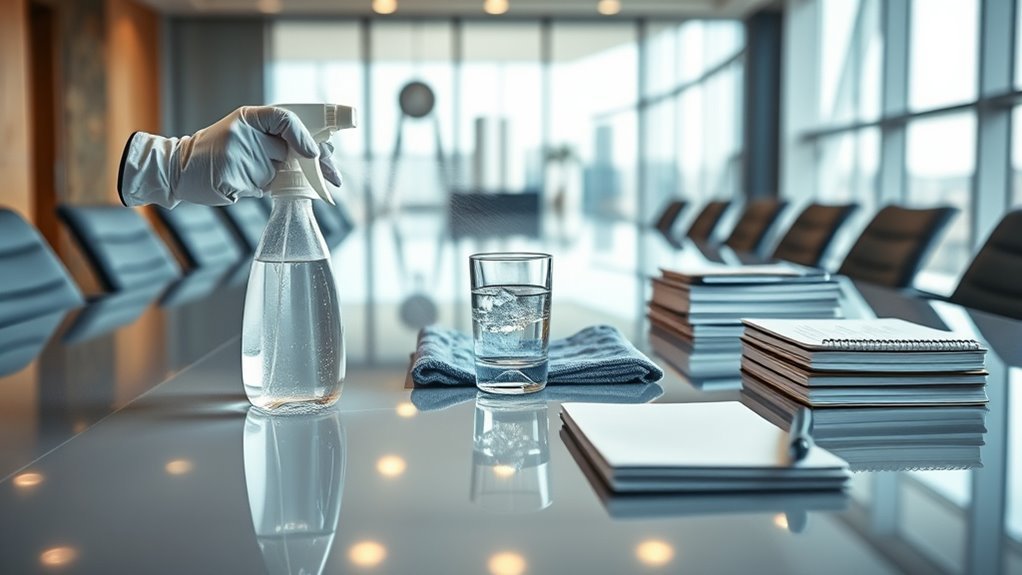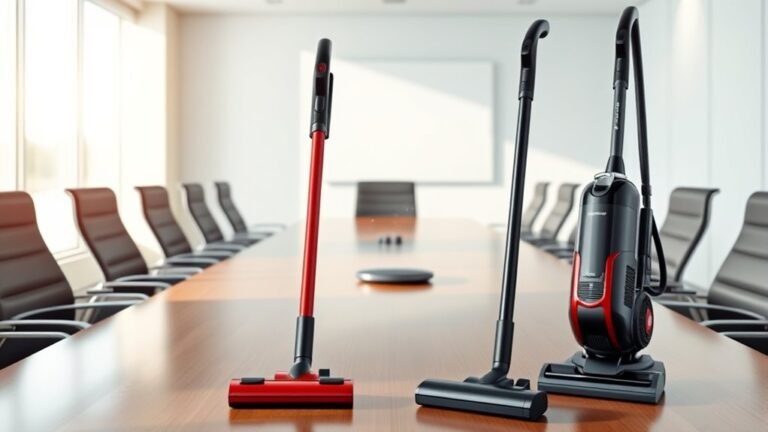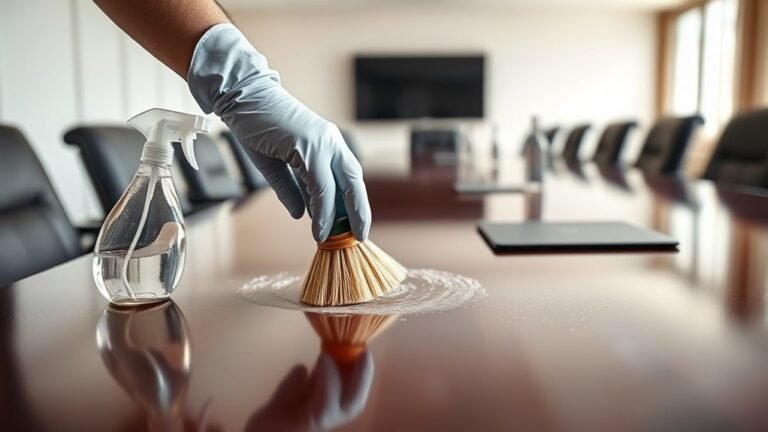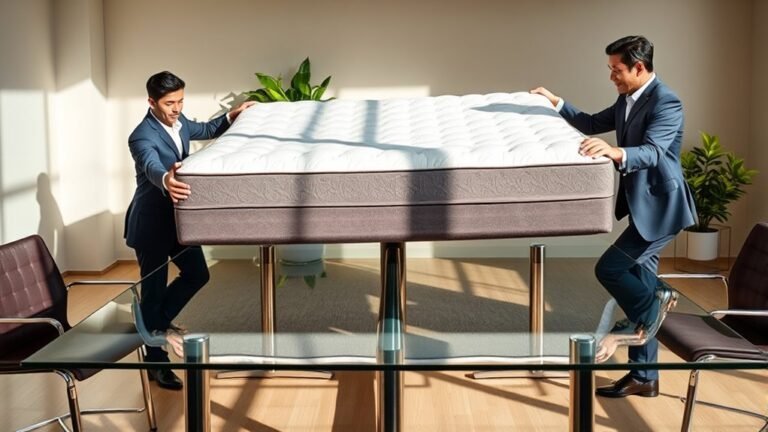Step-By-Step Guide to Cleaning Conference Table
To clean your conference table effectively, first gather supplies like a microfiber cloth, soft brush, disinfectant, and warm water. Clear all items and arrange chairs neatly. Dust the surface and crevices carefully to avoid scratches. Apply a suitable disinfectant evenly, making sure you don’t oversaturate the wood or material. Wipe down thoroughly and dry it to maintain hygiene. You’ll also want to keep up regular care to prolong its life—there’s more to guarantee your table stays spotless and welcoming.
Gather the Necessary Cleaning Supplies
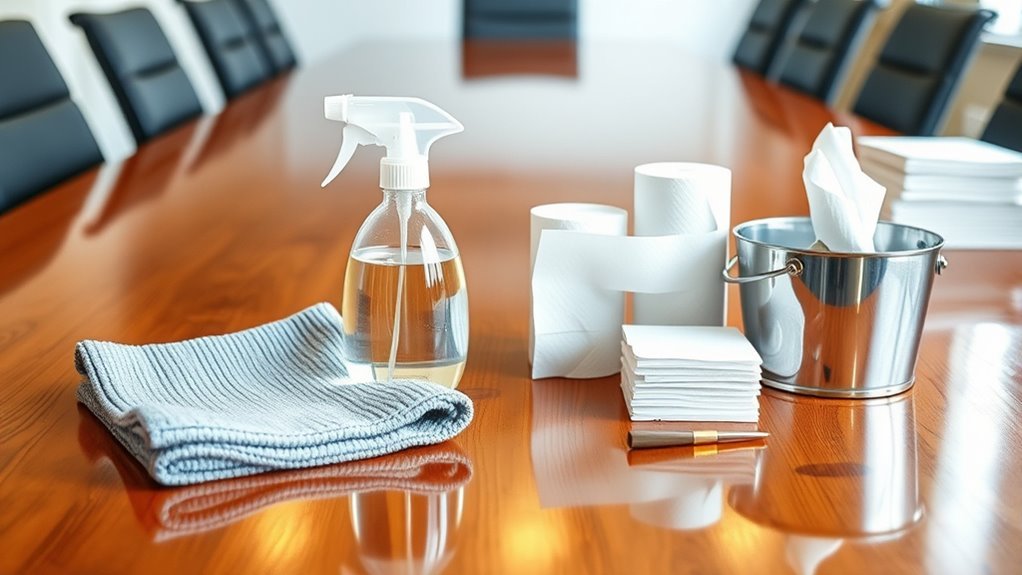
Before you begin cleaning the conference table, you’ll need to gather the right supplies to guarantee an efficient and thorough job. Start by selecting cleaning agents suitable for the table’s material to avoid damage. You’ll want a microfiber cloth, a soft-bristled brush, disinfectant spray, and a bucket with warm water. Effective cleaning techniques involve using the cloth for wiping surfaces and the brush for crevices. Organize your supplies neatly within reach to maintain workflow and prevent interruptions. Having everything systematically arranged lets you move seamlessly from one step to another, saving time and effort. This preparation assures you maintain freedom of movement and focus, making the cleaning process both effective and satisfying. Proper supply organization is key to executing your cleaning techniques with precision. Using eco-friendly cleaners helps protect indoor air quality while ensuring the table surface remains undamaged.
Clear and Prepare the Conference Table
Once you’ve gathered your supplies, you’ll want to clear everything off the conference table completely. Remove papers, devices, and personal items, placing them in designated areas to maintain order. This step is essential for a fresh start and respects meeting etiquette by ensuring the space is neat for all participants. Next, check the table arrangement; make sure chairs are evenly spaced and aligned, promoting a balanced and inviting environment. Proper table arrangement encourages smooth communication and reflects professionalism, which supports an atmosphere of freedom and openness during discussions. Preparing the table this way not only facilitates effective meetings but also signals respect for everyone’s time and presence. Taking these deliberate steps sets the foundation for thorough cleaning and an efficient meeting space. Additionally, organizing supplies and cleaning tools beforehand can improve efficiency by allowing quick access during the cleaning process.
Dust and Remove Surface Debris
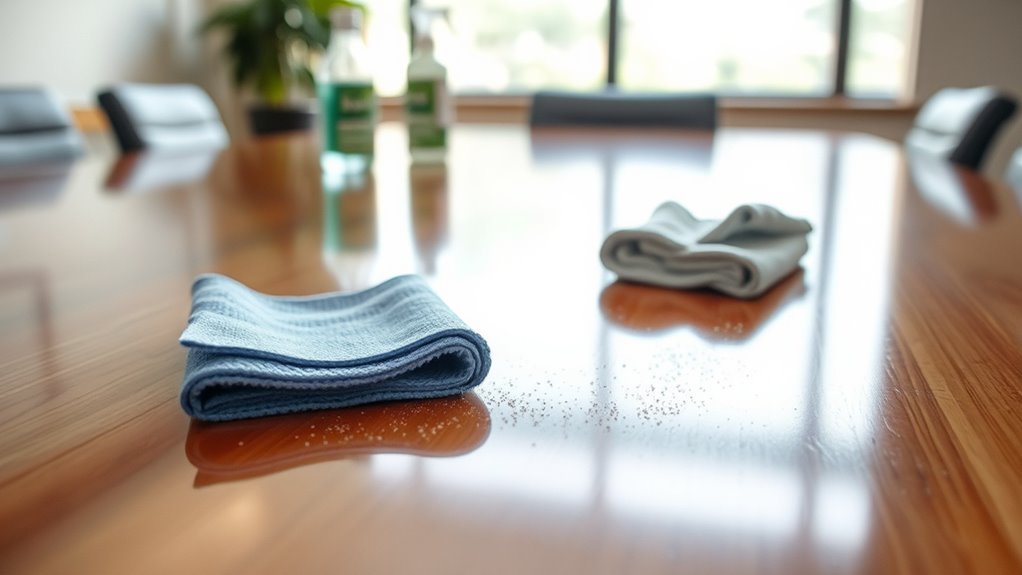
A thorough dusting is essential to maintain a clean and professional conference table. Effective dust removal not only enhances appearance but also contributes to surface protection, preventing scratches and buildup. Start by:
- Using a microfiber cloth to gently lift dust without scratching the surface.
- Paying close attention to corners and edges where debris tends to accumulate.
- Employing a soft-bristled brush for crevices and intricate details.
Additionally, working in one direction helps avoid scattering dust and ensures quick and effective dusting techniques.
Clean and Disinfect the Table Surface
Although dusting removes loose particles, you’ll need to clean and disinfect the table surface to eliminate germs and stains effectively. Start by selecting a disinfectant compatible with your table’s material to guarantee proper surface protection. Apply the disinfecting solution evenly using a soft cloth or spray bottle, avoiding excess moisture that could damage the finish. Allow the disinfectant to sit for the recommended contact time to maximize germ elimination. Afterward, gently wipe the surface with a clean, damp cloth to remove residue, then dry thoroughly. Consistently applying these disinfecting techniques not only maintains hygiene but also preserves your conference table’s integrity, giving you the freedom to focus on meetings without worrying about cleanliness or surface damage. For best results, ensure you use effective disinfectants that are safe for frequent use on high-touch surfaces.
Maintain the Table’s Appearance Between Cleanings
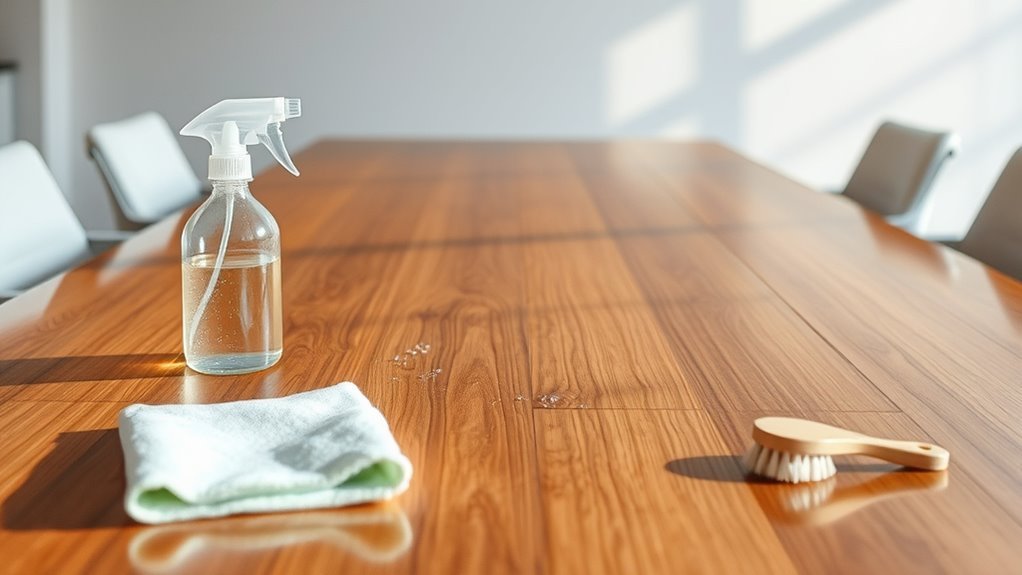
To keep your conference table looking its best between deep cleanings, you’ll want to adopt simple daily habits that prevent buildup and damage. Regular maintenance is key to appearance enhancement and prolongs your table’s lifespan. Here’s what you can do:
- Wipe Spills Immediately: Use a soft, damp cloth to clean spills right away, preventing stains and sticky residues.
- Dust Daily: Light dusting with a microfiber cloth removes particles that can scratch or dull the surface.
- Use Protective Accessories: Place coasters and pads under items to avoid scratches, heat marks, and moisture rings.
- Always follow manufacturer cleaning recommendations to ensure you use compatible cleaning materials that protect your table’s finish.
Frequently Asked Questions
How Often Should a Conference Table Be Professionally Deep Cleaned?
You’ll want to embrace a gentle rhythm with your conference table’s cleaning frequency, allowing it to shine without overwhelming effort. Typically, scheduling a professional deep cleaning every six months keeps your space feeling fresh and inviting. This balance guarantees grime and buildup don’t silently accumulate, preserving the table’s appearance and longevity. Of course, if your meetings are frequent or snacks common, you might consider more frequent deep cleaning to maintain that welcoming freedom.
Can I Use Natural Cleaners Instead of Chemical Disinfectants?
Yes, you can use natural alternatives instead of chemical disinfectants, but keep in mind cleaning effectiveness. Ingredients like vinegar, baking soda, and lemon have antimicrobial properties, though they might not eliminate all germs as thoroughly as commercial chemicals. If you value freedom from harsh chemicals, natural options work well for routine cleaning, but for deep disinfecting, especially in high-traffic areas, you might need stronger products to guarantee proper sanitation.
What Are the Best Materials for a Conference Table to Resist Stains?
Imagine a sleek conference table that resists coffee spills versus one that soaks them up instantly. You’ll want materials with durable wood finishes like polyurethane or epoxy, known for excellent stain resistance. These finishes create a protective barrier, keeping your table looking pristine while allowing freedom from constant worry. Opt for hardwoods like maple or oak, treated with these finishes, to combine elegance with practical stain defense, ensuring longevity and easy maintenance.
How Do I Remove Stubborn Stains Like Ink or Coffee?
When tackling stubborn stains like ink or coffee, you’ll want to focus on effective stain removal techniques. Start by blotting the area gently to avoid spreading. Use a mild detergent mixed with water, applying it with a soft cloth. For ink, rubbing alcohol works well—dab it carefully. Always test cleaning products on a small spot first. These cleaning techniques help preserve your table’s finish while freeing you from tough stains.
Are There Special Considerations for Cleaning Electronic Components on the Table?
When cleaning electronic components on your table, prioritize electronic safety by always unplugging devices first. Avoid using excessive moisture; instead, opt for a lightly dampened microfiber cloth to prevent damage. Use gentle cleaning techniques, like compressed air for dust removal, and avoid harsh chemicals that could harm sensitive parts. Taking these precautions guarantees your electronics stay safe while you maintain a clean, functional workspace.
